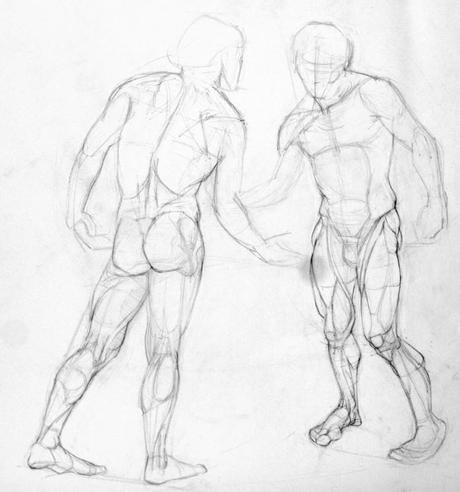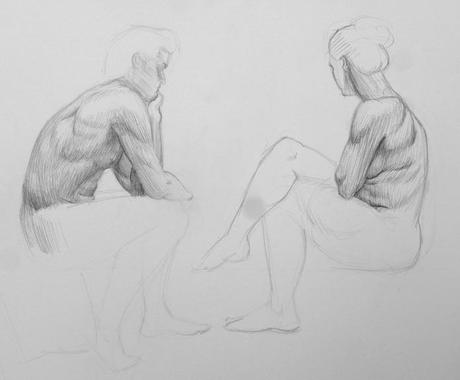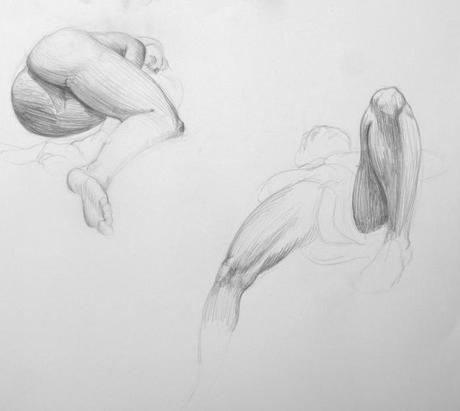
Mikes – beginnings of a drawing of two sculptures of the same model sculpted by two different sculptors
Despite my suspicion of government arts funding, I recently undertook something of an experiment in applying for a rather large grant involving a residency in Berlin. Unsurprisingly, I was unsuccessful, but I think this very inevitability makes for an interesting discussion.
The grant I applied for is known as a ‘Skills and Arts Development General and Residency grant.’ Now, the government may use a lot of words to express itself, but I know from experience that each and every word is agonisingly selected, rejected and reselected to give as precise a meaning as possible. In this case, then, I was sure I was on the right track in emphasising that I intended to use the grant to develop my skills. The grant has but two criteria—the application must:
- demonstrate a high degree of artistic merit in the applicant’s work to date.
- demonstrate the potential for the project to contribute to the applicant’s professional development.
Ten images were to be supplied to address the first, and a very slim ‘project description’ to address the second, expressing ‘what you intend to do; explain why you are interested in and passionate about particular issues, materials, media, etc; and how your project contributes to your personal development.’ It seems I misunderstood the thrust of this development when I suggested that I would visit galleries, make copies, draw consistently from the model, train in anatomy and produce a lot of art in the studio. My personalised feedback suggested that ‘whilst your proposal expresses reasons for being in Berlin, a stronger rationale with more tangible and confirmed reasons such as meetings with artists, curators, mentorships, exhibitions or galleries would have further strengthened your application. It’s advised to research in advance of the application and develop networks and professional development opportunities before going abroad.’ I see now that the grant is not at all about art skills development, but purely about professional skills development—networking, forging connections, liaising with specific people. You can draw anywhere—it’s specific people, not resources or characteristics of the city, that make Berlin a necessary stopover in an artist’s career.
I accept that this is not where my interests lie, and that I am more focused on concentrating on my work, improving my abilities, and immersing myself in a place. In this respect, fair call.

However, some interesting points come out later in the response. ‘It is important to continually build on your exhibition history to demonstrate your artistic merit.’ Ah, a numbers game. It certainly is difficult to make those value judgments to determine artistic merit, but it’s easy to count how many shows are on your CV. I understand this to a point, but feel uneasy about it. Surely there are many paths an artist’s career can take, and perhaps some meander a little more slowly through education, and place more demands on themselves to produce quality work rather than rushing to have anything and everything seen. Not so, if you are going to approach government, which abides by the current standard path. Most careers follow a standard path—so why not that of the artist? Attend art school, have fifty shows in the next two years, and you’re rolling. If you’re doing it differently, you’re not doing it at all. It’s easy for an artist to question herself when she sees herself deviate from this clearly defined path.

Nima and Kate deep in thought
Why, then, being serious about art, haven’t I embarked on that accepted path? Yes, I’ve exhibited, and yes, I’ve studied, but not Fine Art at a university. And while I’ve flirted with design several times for the last decade, I’ve never had the nerve to study ‘real,’ ‘serious’ art, because, well, philosophers do philosophy better and I really just wanted to learn to draw. Underwhelmed by the course descriptions each time I researched study options, and by the work in graduate exhibitions in Queensland, each and every time I came to the conclusion that art is not for me. Art in the modern world has mutated into some ghastly, non-rigorous, ill-researched form of intellectualism in which deliberately obtuse artists’ statements eclipse the visual element. It’s enough to explain an idea to get the concept, and the visual aspect is redundant. This is a complaint for another time. The point is, what attracts me to drawing, and to painting, is the immense power in this visual expression. I am but a humble painter, not an artist.

Sadly for me, however, ‘The Australia Council funds innovative contemporary visual art practice,’ and the most exemplary applications the Australia Council received of said innovative contemporary visual art practice had a strong ‘conceptual basis for a project in both ideas conveyed in the project description and in the support material.’ Alas, I left out the ideas! I saw the bit about enthusiasm for a medium, and harped on a bit about drawing, and about paint, and didn’t contextualise any of this in terms of tensions and dichotomies and gender roles and quantum physics! Concepts are the currency of the day, and if a painter is to dive into the murky world of art she must adapt: ‘Whilst the visual arts panel is highly supportive of classical fine art or heavily skills based practice, I suggest your application will be more competitive when this is supported by a conceptual rationale.’ And so, my skill-hungry application for the ‘Skills and Arts Development General and Residency grant’ was eaten alive by the panel. But they send me their best wishes.

